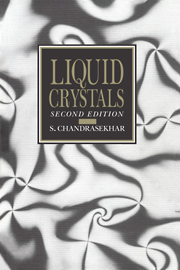6 - Discotic liquid crystals
Published online by Cambridge University Press: 08 January 2010
Summary
Description of the liquid crystalline structures
Since the early investigations of Lehmann and others elucidating the relationship between liquid crystalline behaviour and chemical constitution, the accepted principle was that the molecule has to be rod-like in shape for thermotropic mesomorphism to occur, but it has emerged during the last decade that compounds composed of disc-like molecules may also exhibit stable mesophases. Some typical discotic molecules are shown in fig. 6.1.1. Generally speaking, they have flat (or nearly flat) cores with six or eight (or sometimes four) long chain substituents, commonly with ester or ether (but rarely more complex) linkage groups. Available experimental evidence indicates that the presence of these side chains is crucial to the formation of discotic liquid crystals. The mesophases whose structures are clearly identified fall into two distinct categories, the columnar and the nematic. A smectic-like (lamellar) phase has also been reported but the precise arrangement of the molecules in each layer is not yet fully understood.
The basic columnar structure is as illustrated in fig. 1.1.8(a); it is somewhat similar to the hexagonal phase of soap–water and other lyotropic systems (fig. 1.2.2). However, a number of variants of this structure have been found. Fig. 6.1.2 presents the different two-dimensional lattices of columns that have been identified; here the ellipses denote discs or, more precisely, cores that are tilted with respect to the column axis. Table 6.1.1 gives the space groups of the columnar structures formed by some derivatives of triphenylene. (These are planar space groups that constitute the subset of the 230 space groups when symmetry elements relating to translations along one of the axes, in this case the column axis, are absent.)
- Type
- Chapter
- Information
- Liquid Crystals , pp. 388 - 417Publisher: Cambridge University PressPrint publication year: 1992
- 1
- Cited by

